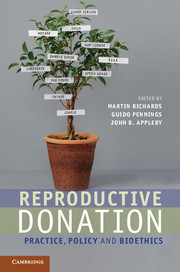Book contents
- Frontmatter
- Contents
- Contributors
- Acknowledgements
- 1 Introduction
- 2 The biology of donation
- 3 Ethics for reproductive donation
- 4 Parenthood – whose right is it anyway?
- 5 Reproductive donation
- 6 UK and US perspectives on the regulation of gamete donation
- 7 Gamete and embryo donation
- 8 The legal and ethical regulation of transnational donation
- 9 Balancing ethical criteria for the recruitment of gamete donors
- 10 Challenges in intra-family donation
- 11 ARTs and the single parent
- 12 Reproductive donation and justice for gay and lesbian couples
- 13 Is disclosure in the best interests of children conceived by donation?
- 14 Identifiable donors and siblings
- 15 Ethical issues in embryo donation
- 16 Reproduction through surrogacy
- 17 Some conclusions regarding the interaction of normative and descriptive elements in reproductive donation
- Index
- References
14 - Identifiable donors and siblings
implications for the future
Published online by Cambridge University Press: 05 August 2012
- Frontmatter
- Contents
- Contributors
- Acknowledgements
- 1 Introduction
- 2 The biology of donation
- 3 Ethics for reproductive donation
- 4 Parenthood – whose right is it anyway?
- 5 Reproductive donation
- 6 UK and US perspectives on the regulation of gamete donation
- 7 Gamete and embryo donation
- 8 The legal and ethical regulation of transnational donation
- 9 Balancing ethical criteria for the recruitment of gamete donors
- 10 Challenges in intra-family donation
- 11 ARTs and the single parent
- 12 Reproductive donation and justice for gay and lesbian couples
- 13 Is disclosure in the best interests of children conceived by donation?
- 14 Identifiable donors and siblings
- 15 Ethical issues in embryo donation
- 16 Reproduction through surrogacy
- 17 Some conclusions regarding the interaction of normative and descriptive elements in reproductive donation
- Index
- References
Summary
Introduction
The long-standing ethical and policy debate about whether gamete donors should remain anonymous or be identifiable has been conducted with very limited empirical evidence about the implications of open-identity donation for those involved. While there is a growing consensus that the use of identifiable donors is preferable to the secrecy that has traditionally surrounded gamete donation, there is uncertainty around the consequences of policy decisions to remove donor anonymity, particularly regarding potential outcomes should donor offspring wish to meet their donor or other families created using their donor’s gametes. Open-identity donation is now available and is sometimes mandatory in several countries around the world, although it will be some years before the social effects of this regulatory change are realized. In the UK, for example, the entitlement of individuals conceived using donated gametes from 1 April 2005 onwards to receive identifying information about their donor at age 18 will not come into effect until 2023.
There are various types of identifiable donors. Clinics may use ‘identity-release’ donors whose identifying information is accessible once the child conceived with their gametes reaches a specified age; information may or may not be available to parents before this time. Alternatively, in instances where children have been conceived using anonymously donated gametes, the donor may choose to revoke their anonymity and make their identity known at a later stage. Lastly, the donor’s identity may be known from the time of the child’s conception, as is the case when prospective parents ask friends or relatives to donate their gametes, a practice that appears to be on the increase since the removal of donor anonymity. This chapter is primarily concerned with the first two types of open-identity donation, that is identity-release donation and formerly anonymous donation, and will focus on donations that occur within the context of the clinic (for a discussion of intra-familial donation, see Vayena and Golombok, Chapter 10).
- Type
- Chapter
- Information
- Reproductive DonationPractice, Policy and Bioethics, pp. 250 - 269Publisher: Cambridge University PressPrint publication year: 2012
References
- 10
- Cited by



